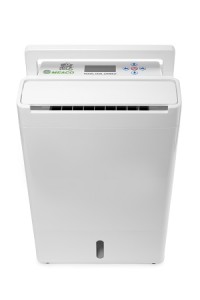
The Meaco Zambezi has all the bells and whistles you’ll need. Our choice for Best Dehumidifier 2018.
Buying a dehumidifier is a straight forward process once you know exactly what to look for.
As each dehumidifier has slightly different features we will show you exactly what to look for so that you can buy a dehumidifier which most suits your needs.
First of all think about why you want to buy a dehumidifier.
Do you want to buy a dehumidifier because you want to get rid of mould and condensation, is it because you want to lower chances of suffering from airborne allergies or maybe you just want healthier and cleaner air for greater relaxation when meditating or doing yoga.
Unless you want to keep condensation from your car windows we recommend that you buy a full size electrical dehumidifier which comes from a recommended dehumidifier brand such as Meaco, EcoAir, Ebac and Inventor etc.
If you don’t want to read the whole article simply scroll down to see our handy ‘How To Buy a Dehumidifier ‘checklist and our recommendations.
[wp_ad_camp_1]
1. Compressor or Desiccant Dehumidifier
Your first choice should be to decide between a compressor or desiccant dehumidifier.
Compressor dehumidifiers work better in warmer temperatures such as in houses which have been warmed by radiators.
Due to how they are constructed compressor dehumidifiers are inefficient in cooler temperatures and are generally heavier and louder than desiccant models.
Desiccant dehumidifiers have an even extraction rate as long as the temperature is above freezing. Therefore desiccant dehumidifiers are ideal for outdoor use such as in boats, sheds, garages, mobile homes, nurseries etc
2. Stated vs Actual Extraction Rates
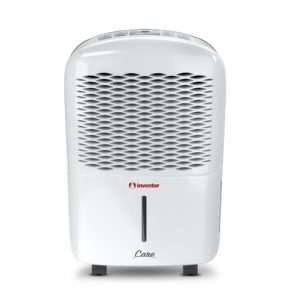
The Inventor 12L dehumidifier is great value for money as it contains features found on more expensive dehumidifiers. Be sure to check it out.
When buying either type of dehumidifier you will find a variance between the stated and actual extraction rates.
Compressor type dehumidifiers are typically tested in temperatures of 30°C and 80% relative humidity and their stated extraction rate reflects this test climate.
The above test climate is obviously different to UK winter weather which is when most people use dehumidifiers therefore actual extraction will be far less than the stated extraction rate.
A good loose rule of thumb (as dehumidifier brands, models and environments differ) is to half the stated extraction and then subtract an extra 15%. So a compressor dehumidifier with a stated 20 litre extraction rate will likely only extract around 8.5 litres per day during the UK winter.
Desiccant dehumidifiers fare better as their typical test climates are lower than those of compressor dehumidifier test climates.
Test climates for desiccant units seem to vary more than those of compressor dehumidifiers but a loose rule of thumb is to subtract 20% from the stated extraction rate to get the actual extraction rate. So a desiccant dehumidifier with a stated 8 litre extraction rate will probably extract around 6.5 litres of moisture per day.
Please remember these figures are very approximate as there are so many variables to take into account.
3. Dehumidifier Size
Unless you are looking for a car or wardrobe dehumidifier we would recommend sticking to full model electrical dehumidifiers.
For a small to medium room you might want to look for a stated 10 litre compressor dehumidifier or a stated 6 litre desiccant dehumidifier.
For medium to large rooms or areas (such as the landing of a house) then you could look at larger compressor dehumidifiers with a 16 litre extraction rate or desiccant dehumidifiers with a 8 litre extraction rate.
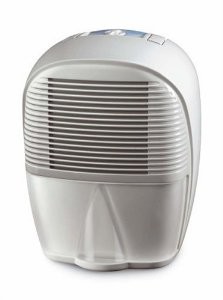
Our tests have shown that dehumidifiers like the Delonghi Dem 10 actually consume less power than stated on other dehumidifier review websites.
4. Running Costs and Energy Saving Technology
Dehumidifier running costs are lower than most people expect with many dehumidifiers costing around 3p per hour to run in their low fan speeds.
When using Laundry Mode to dry laundry inside then the cost could rise up to around 8p – 9p per hour depending on the dehumidifier brand and model and your electricity rate (look on your last bill to find out your rate).
Many dehumidifiers consume around 200 watts at the low fan setting and around 650 watts on full power.
Top of the range dehumidifiers feature energy-saving technology through which the dehumidifiers change settings automatically depending on the humidity levels in the air. This way your dehumidifier is operating at its most efficient setting at all times saving you considerable operating costs.
You can read more in our how long should you run a dehumidifier article.
5. Operating Volume
One of the main dehumidifier concerns is operating volume.
Compressor dehumidifiers are generally louder than desiccant models.
Operating volume for compressor dehumidifiers is generally between 42 db(A) and 48 db(A) (depending on brand and model of course. Desiccant dehumidifiers seem to operate between 38 db(A) and 44 db(A).
6. Number of Fan Speeds
Be sure to check how many fan speeds your new dehumidifier has. The more fan speeds your dehumidifier has the greater extraction control you have.
7. Continuous Drainage Option
If you wish to use your dehumidifier in a remote or less visited location such as holiday homes, caravans, mobile homes, sheds and garages etc then you should buy a dehumidifier with a continuous drainage option.
With this feature you attach a hose (usually supplied) to the dehumidifier. The hose bypasses the water tank so all collected water will flow down into the sink or drain.
Note that most continuous drainage features on dehumidifiers are gravity led so the dehumidifier will have to be at a level higher than the drain or sink.
8. Water Tank
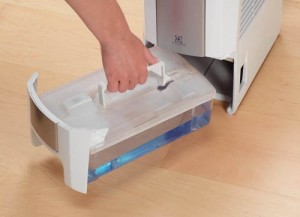
Water tank features to check for include the pull out handle, the carry handle, the lid and the see through panel to gauge the water level.
The water tank, as the name suggests, is where the collected water is stored. There are a few water tank features that you might like to check out.
Water Tank Handle
First of all check where the handle is to pull the tank out when it is full.
In our experience we find that we prefer indent handles on the side over a single indent handle underneath the front of the water tank. This is true especially when the water tank is over 2 litres and can get heavy when the tank is filled with lots of water.
Water Tank Lid
Does the water tank have a lid in order to avoid splashing? There’s nothing worse than accidentally spilling water on the floor when carrying the full water tank to the sink for emptying.
Pull Up Handle
Some water tanks also feature a pull up handle from the center of the water tank that you can hold when bringing the full tank to the sink however we just prefer to hold the tank by its sides as we feel this is safer.
Anti-Mould Coating
The Meaco Zambezi features an anti-mould coating on the inside of its water tank.
With some dehumidifier brands and models when people put the dehumidifier away for the summer the don’t dry the water tank properly and as a result mould growth occurs which give the people a nasty shock the next September. We like the anti-mould coating idea.
9. Type of Controls
Older dehumidifiers such as the Delonghi Dem 10 still feature manual controls. More modern dehumidifiers feature nice soft touch buttons. Dehumidifiers such as the Dem 10 are still very popular though as they are true work horses and are fairly low energy.
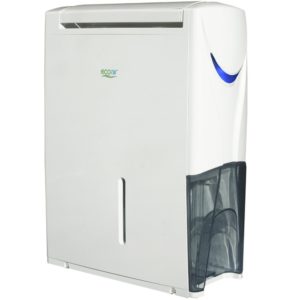
The EcoAir DC202 features a 3 in 1 filtration system which is excellent for keeping airborne allergies at bay.
10. Does Anyone in Your House Suffer From Airborne Allergies
Airborne allergies can wreak havoc with your body however a well-chosen dehumidifier can help lessen the risk of attack.
Dehumidifier Filter
First of all ensure that you purchase a dehumidifier with an anti-bacterial filter. There are different types of anti-bacterial filters and these can include silver nano filters (popular with EcoAir dehumidifiers) or multi-filtration systems with pre-filters and charcoal filters which also eliminate smells (again we like to point out an Ecoair dehumidifier).
Be sure never to wash anti-bacterial filters with water as you’ll wash away the anti-bacterial properties. A quick vacuum will clean the filter easily.
Ioniser
People suffering from airborne allergies may find it difficult to breathe on certain days. This could be because there are more positive ions in the air than negative ions. An ioniser releases negative ions into the air to balance out the positive ions.
Most ionisers on dehumidifiers have a reach of around 1 meter – 1.5 meters. Our choice, when purchasing a dehumidifier for ioniser reach, would be the Meaco Zambezi on which the ioniser reaches a massive 10 meters!
Those who are into yoga, pilates, meditation and reiki etc should also purchase dehumidifiers with an anti-bacterial filter and ioniser as the cleaner air due to these features promotes relaxation.
11. Drying Laundry Inside
Drying washing indoors can cause property damage due to condensation running down your walls and windows. Worse still, is the fact that drying clothes inside can also cause very serious illness for the occupants of the property.
A simple solution to the above problems is to place a dehumidifier next to the washing that is drying so that the dehmuidifier catches all the moisture that is released from the clothes. This way your walls and windows will stay dry and you don’t have to worry about getting sick.
There are a few features to look for on dehumidifiers if you want to dry clothes inside.

As the name implies the Meaco Dehumidryer is great for drying clothes indoors. Simply click the image to read more.
Laundry Mode
Laundry Mode places the dehumidifier into its most powerful setting and can push humidity levels down to a very dry 35% or more. Some dehumidifier models you must turn of yourself or you can use a timer.
The Meaco Zambezi desiccant dehumidifier actually has an energy-saving feature on laundry mode so that when the humidity level hits 35% the dehumidifier starts to run on half power thereby saving you bundles of electricity.
Timer
A timer can stop the dehumidifier from operating too long at full power. Typically timers are set in 1 hour increments and many timers can run from 1 hour to 24 hours.
Movable Louvre
Some dehumidifiers with laundry mode and a timer also feature a movable louvre. You can point this louvre at the damp clothes so that the warm air generated by the dehumidifier blows over the clothes and helps dry them quicker.
A louvre is also handy for pointing at a particularly stubborn damp spot on a wall.
12. Condensation on Windows
If you hate waking up to a window full of condensation then we have the perfect solution for you.
Up until 2016 you manually had to push the timer button on your dehumidifier for it to work.
Now you can buy the best UK dehumidifier (in our opinion anyway) the Meaco Zambezi and set the timer to come on at some point in the future.
So you can set the dehumidifier to come on at 5 am, while you are asleep (it’s a desiccant model so its quiet) and when you wake up 2 hours later your windows will be nice and dry thereby saving your curtains from damp.
But there’s more…..
With the Meaco Zambezi you only have to set the timer once and it will come on at that time every day. This is actually a great feature as you can set and forget and not the other way around.
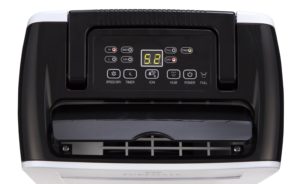
One of our favourite features on a dehumidifier is a LED digital display screen on the control panel.
13. LED Display Panel
We always like to see a LED display panel on our dehumidifier control panel as this makes reading the temperature and humidity levels very easy.
The only true way of knowing the exact humidity level of your room or house without a LED display panel is by buying a damp meter (here we list the best 6).
14. Handy Handle
For most able-bodied people a dehumidifier is fairly simple to pick up no matter what type of handle the unit has. However if you need to pick your dehumidifier up with two hands (for use on a boat for example) then a fold down handle would be easier than an indented handle in the rear of the unit.
15. Castor Wheels
Compressor dehumidifiers can get fairly heavy so it’s a good idea to check if your dehumidifier contains castor wheels as these wheels make transporting your dehumidifier from room to room much easier.
16. Auto Defrost
Due to the way that compressor dehumidifiers work they are not very efficient in lower temperatures. Basically what happens is that the coils inside the dehumidifier get too cold and can’t extract moisture from the air efficiently.
When this occurs the compressor dehumidifier goes into auto defrost mode which allows the coils inside the dehumidifier to warm up so that they can extract moisture efficiently.
Every brand name dehumidifier features auto defrost.
17. Auto Restart
If your house, shed or garage etc suffers from power cuts once in a while then look for the auto restart feature.
Auto restart allows the dehumidifier to automatically restart in the exact setting as it was operating in before a power cut.
As such this feature is particularly handy when the dehumidifier is used in a somewhat remote location.
18. Auto Shut Off

Features such as auto shut off, auto defrost and anti tilt are standard safety features found on all good dehumidifiers (auto defrost is only found on compressor type dehumidifiers not desiccant ones).
If the dehumidifier were to keep running while the water tank was full then more water would be collected and the water tank would overflow.
It is for this reason that dehumidifiers are fitted with the Auto Shut-Off feature which turns off the dehumidifier once the water tank is full. The dehumidifier will only operate again once the water tank has been emptied and reinserted into the dehumidifier correctly.
19. Anti Tilt
Anti-Tilt is another safety feature which, as the name implies, turns off the dehumidifier when it gets a knock and tilts over.
20. Warranty
As with all domestic appliances it pays to check how long the warranty stays valid. Generally speaking the longer the warranty period the more confidence the company has in its products.
Be aware that you can also pay extra for extra warranty coverage. For example if the standard warranty is for a 2 year period then you can pay extra to get cover for an extra year or two or three on top of the original warranty period.
21. Price
Dehumidifiers range in price from around £80 for very basic models to around £300 for very advanced domestic models. We recommend selecting a dehumidifier between the £120 – £220 price range as you can buy some great dehumidifiers with the features that you need around this level.
How To Buy A Dehumidifier Check List
Here is a quick check list if you want to buy a dehumidifier. If you have read the above article you will know what each point means and what you should look for.
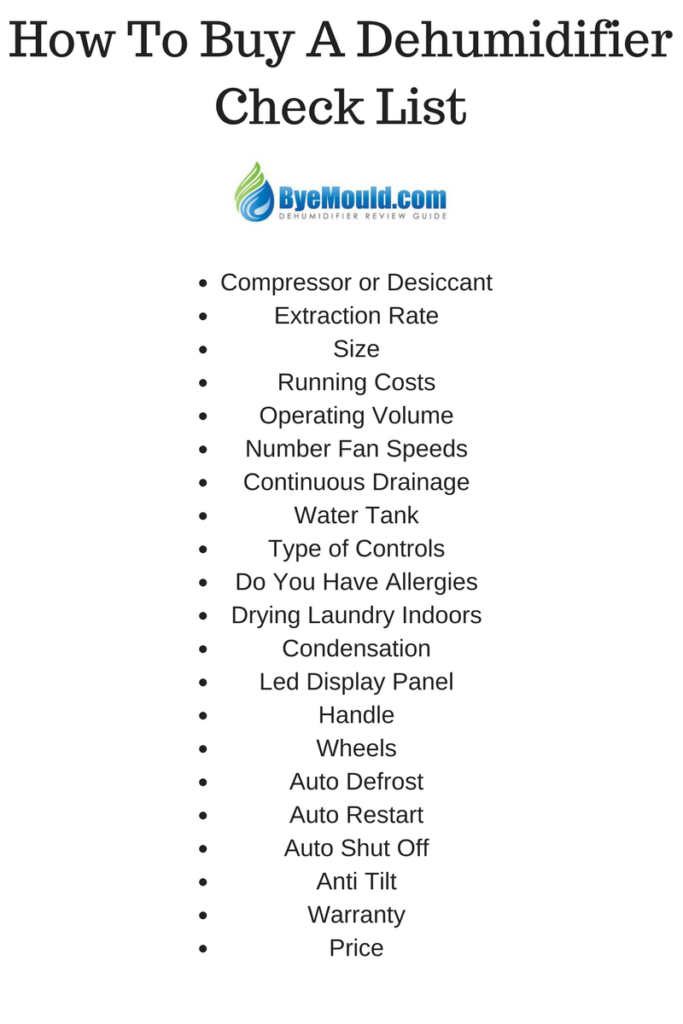
How to Buy A Dehumidifier Conclusion
After reading the above How To Buy A Dehumidifier Guide you will find it very easy to buy a dehumidifier that is right for your needs. If you’re wondering how to use a dehumidifier to dry a room then please read our popular guide.
If you still have any doubts contact us on the email address in the address bar above.
After you have used this guide and purchased a dehumidifier please come back to let us know how handy you found this guide.
Do you have any other questions when it comes to buying a dehumidifier? Let us know in the comments below and we’ll gladly help you.
